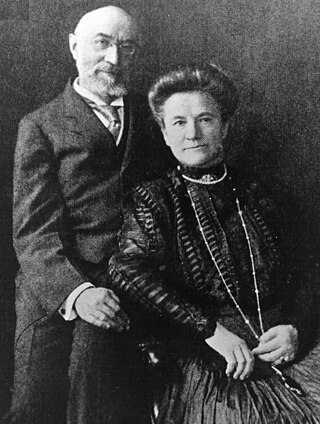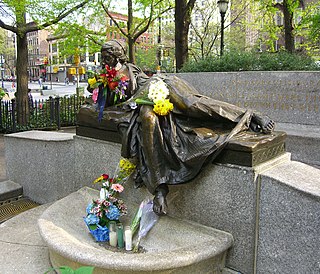See also
- Straus Park, in New York, memorializing Ida and Isidor Straus, who died on Titanic
- The Jack Phillips memorial cloister in Godalming, commemorating the radio operator who remained at his post while Titanic sank
Titanic Memorial can refer to:

John Jacob Astor IV was an American business magnate, real estate developer, investor, writer, lieutenant colonel in the Spanish–American War, and a prominent member of the Astor family. He was among the most prominent American passengers aboard RMS Titanic and perished along with 1,500 people when the ship sank on her maiden voyage. Astor was the richest passenger aboard the RMS Titanic and was thought to be among the richest people in the world at that time, with a net worth of roughly $87 million when he died.

Oscar Solomon Straus was an American politician and diplomat. He served as United States Secretary of Commerce and Labor under President Theodore Roosevelt from 1906 to 1909, making him the first Jewish United States Cabinet Secretary.

Isidor Straus was a Bavarian-born American businessman, politician and co-owner of Macy's department store with his brother Nathan. He also served for just over a year as a member of the United States House of Representatives. He died with his wife, Ida, in the sinking of the Titanic.

Wallace Henry Hartley was an English violinist and bandleader on the Titanic during its maiden voyage. He became famous for leading the eight-member band as the ship sank on 15 April 1912; he and the rest of the band died.

Abraham & Straus, commonly shortened to A&S, was a major New York City department store, based in Brooklyn. Founded in 1865, it became part of Federated Department Stores in 1929. Shortly after Federated's 1994 acquisition of R.H. Macy & Company, it eliminated the A&S brand. Most A&S stores took the Macy's name, although a few became part of Stern's, another Federated division, but one that offered lower-end goods than Macy's or A&S did.

The TitanicMemorial is a granite statue in Southwest Waterfront neighborhood of Washington, D.C., that honors the men who gave their lives so that women and children might be saved during the sinking of the Titanic. Ten days after the sinking on April 25, 1912, a group of women formed a committee to raise money for a memorial to honor the sacrifice, with a limit of $1 per person. After sending thousands of cards to other women throughout the U.S., the funds the committee had raised alongside funding from the federal government was enough to complete the project. A competition was announced for a memorial design and several were submitted. The winning design by Gertrude Vanderbilt Whitney, who later opened the Whitney Museum of American Art, became her first major commission.

Rosalie Ida Straus was a German-American homemaker and wife of Isidor Straus, U.S. Congressman and co-owner of the Macy's department store. She and her husband died during the sinking of the Titanic.
A total of 2,240 people sailed on the maiden voyage of the Titanic, the second of the White Star Line's Olympic-class ocean liners, from Southampton, England, to New York City. Partway through the voyage, the ship struck an iceberg and sank in the early morning of 15 April 1912, resulting in the deaths of 1,517 passengers and crew.

The Titanic Memorial is a 60-foot-tall (18 m) lighthouse at Fulton and Pearl Streets in the Financial District of Lower Manhattan in New York City. It was built, in part at the instigation of Margaret Brown, to remember the people who died on the RMS Titanic on April 15, 1912. Its design incorporates the use of a time ball.
Frank John William Goldsmith Jr., was a young third-class passenger of the RMS Titanic and a survivor of the sinking in 1912. He later wrote a book about his experiences on the ship, published posthumously as Echoes in the Night: Memories of a Titanic Survivor (1991), which featured in the documentary, Titanic: The Complete Story (1994).

Straus Park is a small landscaped park on the Upper West Side of Manhattan, at the intersection of Broadway, West End Avenue, and 106th Street.

Cleburne Building is an apartment building located at the northeast corner of West End Avenue and West 105th Street on the Upper West Side of Manhattan, New York City.

Titanic is a musical with music and lyrics by Maury Yeston and a book by Peter Stone. It is based on the story of the RMS Titanic which sank on its maiden voyage on April 15, 1912.

The Titanic Engineers' Memorial is a memorial in East (Andrews) Park, Southampton, United Kingdom, to the engineers who died in the Titanic disaster on 15 April 1912. The bronze and granite memorial was originally unveiled by Sir Archibald Denny, president of the Institute of Marine Engineers on 22 April 1914. The event was attended by an estimated 100,000 Southampton residents.

The R.M.S. Titanic Maritime Memorial Act of 1986 is a United States Act of Congress that was passed to designate the wreck of the RMS Titanic as an international maritime memorial and to regulate the research, exploration and salvage of the wreckage. The Act became law on October 21, 1986, when it was passed by the 99th United States Congress.

The following events occurred in April 1912:

Memorials and monuments to victims of the sinking of the RMS Titanic exist in a number of places around the world associated with Titanic, notably in Belfast, Liverpool and Southampton in the United Kingdom; Halifax, Nova Scotia in Canada; and New York City and Washington, D.C. in the United States. The largest single contingent of victims came from Southampton, the home of most of the crew, which consequently has the greatest number of memorials. Titanic was built in Belfast, Northern Ireland, and had a "guarantee party" of engineers from shipbuilders Harland and Wolff aboard all of whom were lost in the disaster and are commemorated by a prominent memorial in the city. Other contingents of engineers aboard the ship came from the maritime cities of Liverpool in England and Glasgow in Scotland, which erected their own memorials. Several prominent victims, such as Titanic's captain, were commemorated individually. Elsewhere, in the United States and Australia, public memorials were erected to commemorate all the victims.

Eleanor Elkins Widener was an American heiress, socialite, philanthropist, and adventuress best remembered for her donation to Harvard University of the Widener Library—a memorial to her elder son Harry Elkins Widener, who perished in the sinking of the RMS Titanic.
Benjamin Sumner Welles, Jr. was an American philanthropist who was a descendant of many prominent Colonial families.

The Four Hundred was a list of New York society during the Gilded Age, a group that was led by Caroline Schermerhorn Astor, the "Mrs. Astor", for many years. After her death, her role in society was filled by three women: Mamie Fish, Theresa Fair Oelrichs, and Alva Belmont, known as the "triumvirate" of American society.